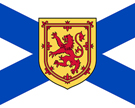 Nova Scotia
Nova Scotia
Halifax
1. Burke-Gaffney Observatory, on the campus of Saint Mary’s University.
2. Observational facility, of an institution for higher education in astronomy.

3. 44° 37' 48" N, 63° 34' 48" W, 5865 Gorsebrook Ave, Halifax.
4. 1972-.
5. A 0.5-metre class observatory used for undergraduate training, and at one time for variable-star research, and other small telescope observational programs.
6. Named after Fr. Michael W. Burke-Gaffney, sj (1896-1979), the first professor of astronomy at SMU, the facility saw first-light in 1972. The primary instrument was an 0.4-metre Cassegrain telescope by Ealing Scientific Instruments, which was replaced in 2013 by a 0.6-metre CDK24 telescope by Planewave Instruments. Regular EPO is also offered for the public at the site. The SMU Astronomy and Physics Department is the largest in the Maritimes.
7. Private site, but accessible to the public via the EPO schedule.
8. https://www.rasc.ca/michael-burke-gaffney
https://www.smu.ca/astronomy-physics/burke-gaffney-observatory.html
1. Citadel clock/"Old Town Clock"/Garrison Clock.
2. Astronomical monument.

3. 44° 38' 49" N, 63° 34' 37" W, South side, Citadel Hill, facing the harbour.
4. 1799-1803.
5. Late-Gerogian clock for the garrison, and town.
6. Conceived by Prince Edward, Duke of Kent, and designed under his direction by Lt. William Fenwick, with movement by Vuillamy. Intended originally as a clock for the garrison only, site selection in the end accommodated the town's needs as well. This is probably the oldest extant free-standing public clock in the country with its original work still in service.
7. Public.
8. Elizabeth Pacey, 1987 Georgian Halifax (Hantsport: Lancelot Press, 1987), pp. 137-146
F.J. Britten, Old Clocks and Watches & Their Makers..., 2nd ed. (London: B.T. Batsford, 1904), pp. 347-354 - on the Vuillamys
Roger Smith, "Vulliamy Family", Oxford Dictionary of National Biography (Oxford: Oxford University Press, 2004)
Parks Canada - Town Clock on Citadel Hill https://www.pc.gc.ca/apps/dfhd/page_fhbro_eng.aspx?id=10277
9.
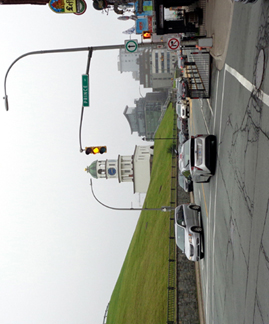
1. Discovery Centre.
2. Institution for popular education in astronomy
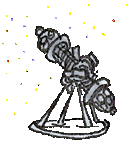
3. 44° 38' 24" N, 63° 34' 12" W, 1215 Lower Water Street, Halifax.
4. 2017-.
5. “Nova Scotia's Hands-On Science Centre”.
6. The original Discovery Centre was located at 1593 Barrington Street (1990-ca. 2016), but had developed out of temporary interactive science exhibits at Dalhousie University in the 1970s. The present award-winning building was designed by the renowned Canadian architectural firm of Moriyama & Teshima, in association with Barrie and Langille Architects. Its front façade features a notable frieze of superimposed lunar map sections. The Discovery Centre includes a Dome Theatre (planetarium) used for regular programming, & education and popular outreach is often presented in cooperation with the Halifax Centre of the RASC.
7. Publicly accessible site.
8. https://mtarch.com/projects/discovery-centre/
https://thediscoverycentre.ca/
9. 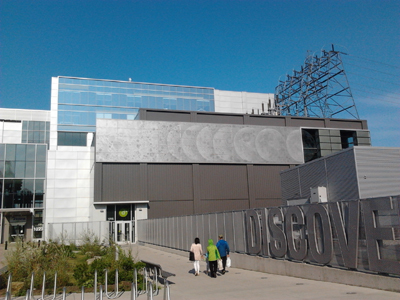

1. Halifax harbour & naval yard.
2. Site of formal and informal instruction in practical astronomy, observational facility, port for astronomical expeditions.



3. 44° 27' 36" N, 63° 35' 16" W
4. 1749-.
5. Associated with the practice of maritime astronomy, and the place where James Cook (1728-1779) acquired his skills in practical astronomy and cartography (1758-1762), and the site of the Halifax Dockyard Observatory (1828-1869).
6. It was recognized from at least the beginning of the 18th century that Halifax harbour could provide an advantageous port for naval and commercial use, in the period of colonial expansion. Given its importance for navigation, a good deal of practical astronomy necessarily took place there once the town was founded, although it took the Board of Ordnance a full decade to establish an official dockyard(!). It was the site, for instance, of Sailing Master James Cook's serious astronomical & cartographic "apprenticeship" under the tutelage of Lieutenant Samuel Holland, & Captain John Simcoe, which he put to good use as the naval leader of the Royal Society's expedition to observe the 1769 transit of Venus from Tahiti.
7. The area is still in use as a naval dockyard, and access is restricted. Their are few remanants of the Georgian period dockyard remaining, and the observatory is long gone.
8. J. C. Beaglehole, The Life of Captain James Cook (Wellington: A. & C. Black Ltd., 1974)
Raymond Tracing the Built Form of HMC Dockyard, Curatorial Report Number 88 (Halifax Maritime Museum of the Atlantic, 1999)
Sheila Johnson Kindred, "Sheila Johnson Kindred", Journal of the Royal Nova Scotia Historical Society 12 (2009), 54-81
Randall C. Brooks and Joel H. Zemel, Origins of the Halifax Dockyard Observatory, Report prepared for the Maritime Museum of the Atlantic, Halifax, NS (Halifax: the Authors, 2016/2019) - avaiable at https://www.rasc.ca/origins-halifax-dockyard-observatory
9. 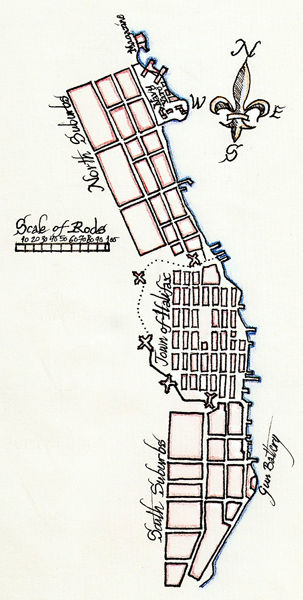 early map of Halifax after Cook
early map of Halifax after Cook
1. Morris Office, also known as the Morris House.
2. Mathematical practioners' premises (i.e., practical astronomers' place of work).

3. Originally at the southeast corner of Hollis and Morris St. 44° 38' 24" N, 63° 34' 12" W; now at the corner of Creighton and Charles St. 44° 39' 36" N, 63° 35' 24" N
4. ca. 1757/1808 (?; based on dendochronology).
5. Building associated with the Morris dynasty of Surveyors General of Nova Scotia (ca. 1749-1851), and possibly the oldest extant workplace for applied astronomy in the country (but see 6 below).
6. As an office for the conduct of practical astronomy the structure most likley dates from the time of Charles Morris II (1731-1802) ca. 1781-, and not Charles Morris I (1711-1781), or just possibly from the time of Charles Morris III (1759-1831) in the 1820s. It had long been taken to be Charles Morris I's surveying office, but recent archaeological and archival work has shown that while it was probably built within his lifetime, it was only aquired by the Morrises after his death, and its original location was in fact not on the Morris' property in Halifax. It retains its significance, however, as a candidate for the oldest surviving workplace for applied astronomy in Canada. The information on the recent historical plaque erected near its original location does not reflect the state of knowledge on its significance.
7. Private site, but it can be seen from the street.
8. Elizabeth Pacey, 1987 Georgian Halifax (Hantsport: Lancelot Press, 1987), pp. 95-96
Jonathan Fowler, Andre Robichaud, & Colin P. Laroque, "Dating the Morris House: A Study of Heritage Value in Nova Scotia," Northeast Historical Archaeology, 47, 1 (2018), 161-186
9. 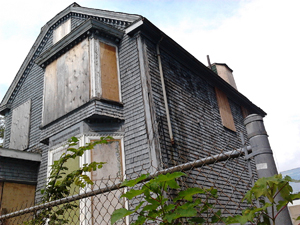 "Morris Office" beofre restoration.
"Morris Office" beofre restoration.
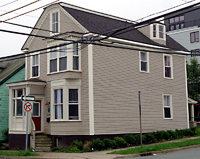 "Morris Office" after restoration.
"Morris Office" after restoration.
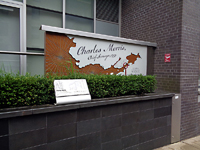 Plaque commemorating Charles Morris
Plaque commemorating Charles Morris
1. Old Burying Ground.
2. Funerary monuments.

3. Intersection of Barrington Street and Spring Garden Road., 44° 38' 38" N, 63° 34' 12" W
4. 1749-1844.
5. One of the oldest settler burial grounds in Canada - contains the graves of some Georgian period practical astronomers (mathematical practitioners).
6. Burial ground established in the first year of the town's existence. Has graves and monuments of some members of the Morris dynasty of practical astronomers, namely Charles Morris III (1759-1831; stone ID 2, mapping ID 5D), and his grandmother Mary Morris (-1789; stone ID 6, mapping ID 5D).
7. Public.
8. https://oldburyingground.ca/
9.
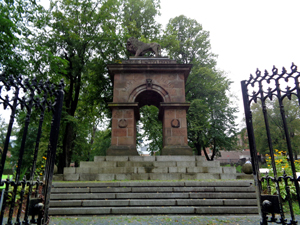 Sebastopol gate
Sebastopol gate
 monument for Marry Morris
monument for Marry Morris
 monument for Charles Morris III
monument for Charles Morris III
1. St. George's Round Church.
2. Building with astronomically themed decoration, and funerary monument.


3. At the corner of Brunswick and Cornwallis Streets, 45° 39' N, 63° 34' 48" W
4. 1801.
5. Church with a comet weathervane, and the burial place of J.F.W. DesBarres.
6. St. George's is an attractive Georgian Palladian structure. On the top of the cupola is a comet-shaped weathervane, said to commemorate the 1835 apparition of Halley's Comet.
In the crypt is buried Col. the Honorable J.F.W. DesBarres (1721-1824), one of the most talented of the practical astronomers active in Georgain Nova Scotia. DesBarres' own very well-equipped observatory was located at Castle Frederickin the Annapolis Valley.
7. The church is home to an Anglican congregation, but can be visited.
8. Elizabeth Pacey, 1987 Georgian Halifax (Hantsport: Lancelot Press, 1987), pp. 78-79.
9.
